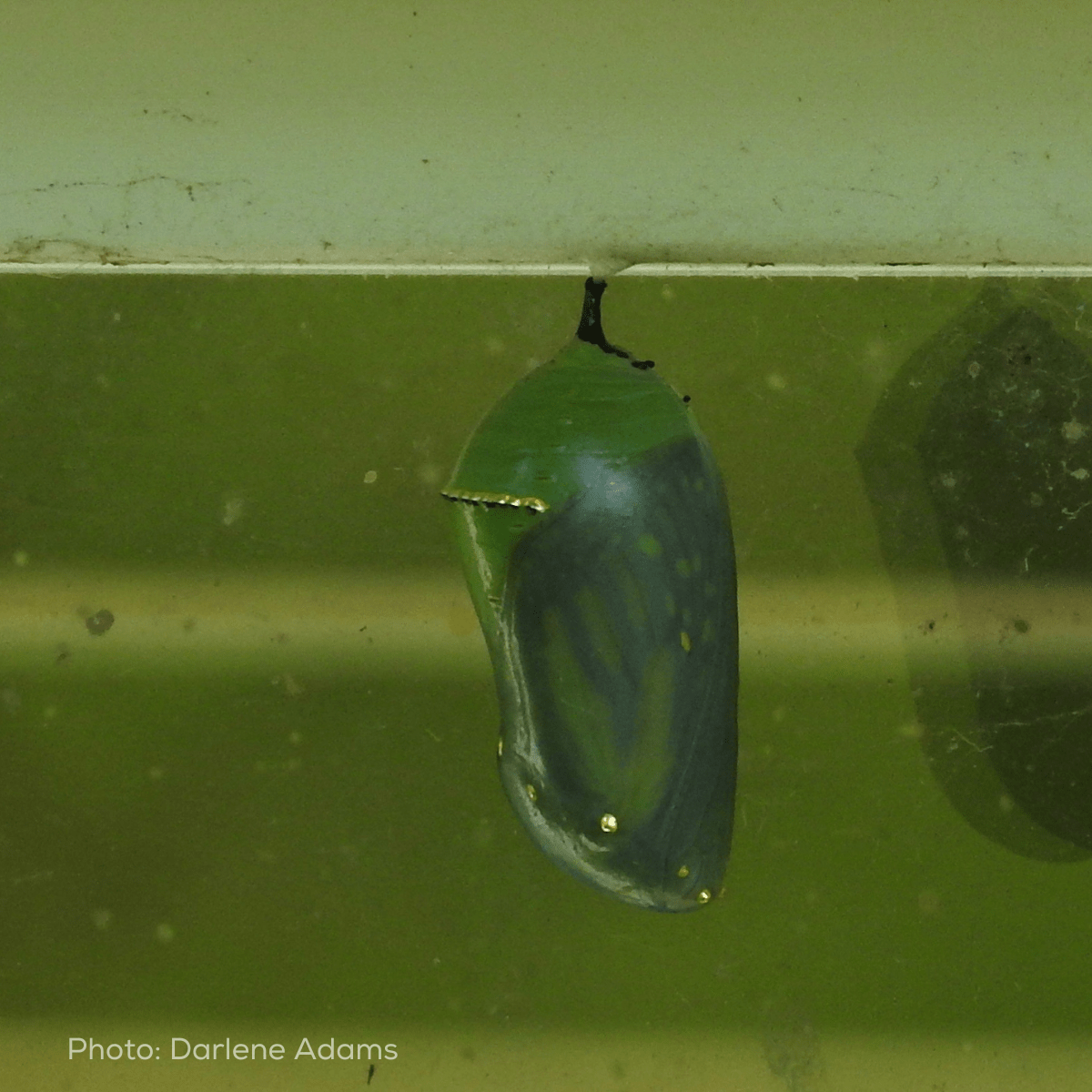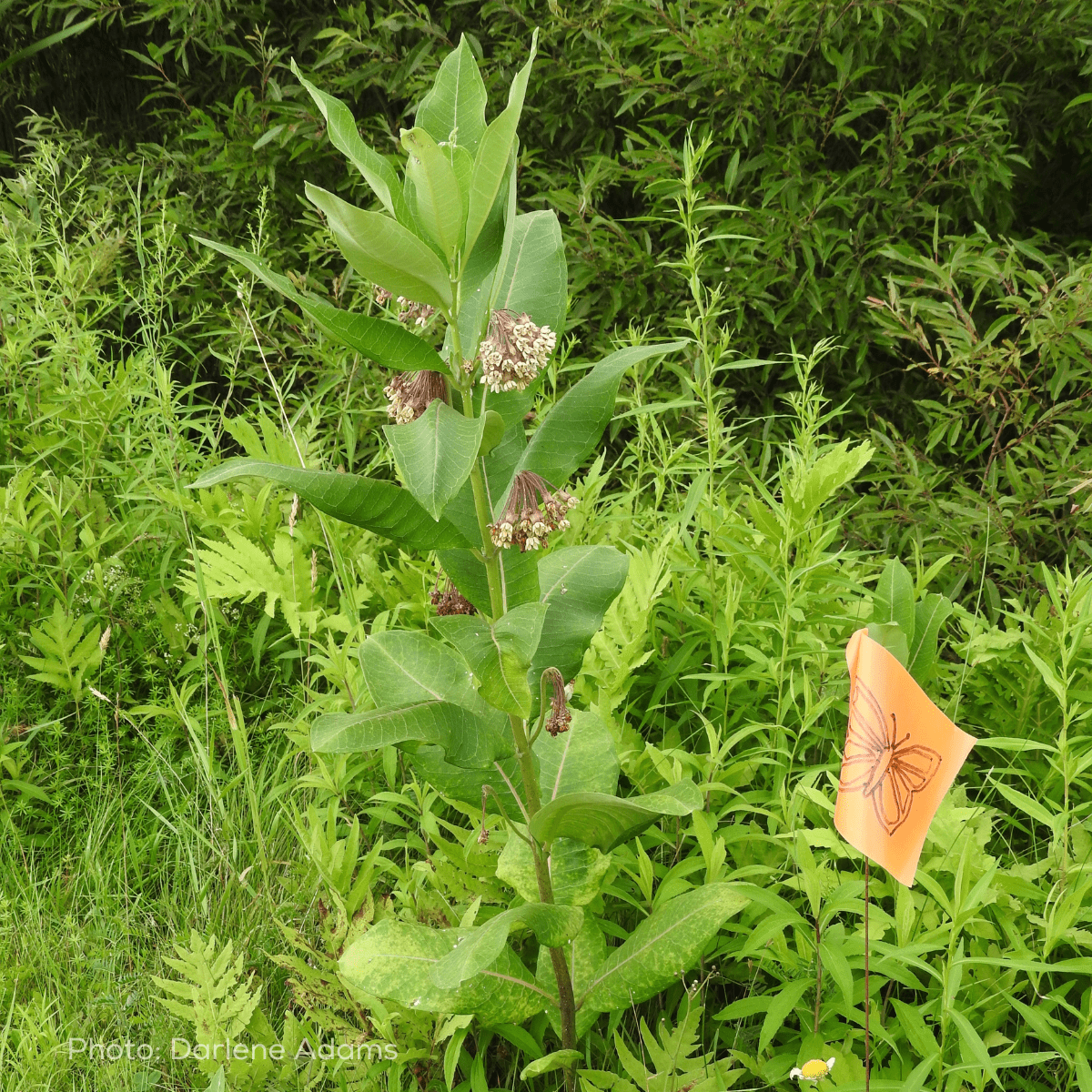Metamorphosis
Written by Jessica Adams (Nature Nerding)
Reading time : 5-6 minutes

“Unless someone like you cares a whole awful lot, nothing is going to get better. It’s not.”
(Quote from Dr. Seuss’ The Lorax)
We often think of conservation as taking place on a large scale, fuelled mainly by grand sweeping gestures like protests and game-changing legislation. But what if I told you that something as simple as caring “a whole awful lot” could be just as important, especially when it comes to finding and claiming our piece in the conservation puzzle?
Caring can take on many forms and in the case of the following story, caring took on the form of a mesh laundry basket…
Back in late August 2018, a retired Townships-dwelling couple stumbled upon an incredible discovery. A pale emerald gem, dotted with gold, hanging from their basement window. What a sight! It was so perfect and beautiful that it hardly looked real. Being of the Nature Nerd persuasion, they suspected it was the chrysalis of the Monarch Butterfly (Danaus plexippus), though it was somewhat uncommon for them to spot one in those days. Intrigued, they began to look around the surrounding plants and much to their surprise and delight came across multiple black, white and yellow-striped caterpillars! More Monarchs! This moment of wonder spurred so much interest they began to do some research.
Even at that time, a few internet searches painted a fairly dismal picture with the words ‘threatened’ and ‘endangered’ making several appearances as they tried to learn more about the Monarch Butterfly. Equipped with some background information, the next step seemed not only obvious but completely feasible: they would care for the Monarchs in their own backyard in whatever way they could. This started as simply “keeping an eye on things”. When they noticed the caterpillars being predated by other insects at an alarming rate, they made the decision to intervene. Enter the mesh laundry basket.
With a handful of caterpillars to house, a mesh laundry basket became the perfect nursery. Placed under the gazebo on their front balcony, furnished with a few sprigs of milkweed and a water source, the caterpillars were able to feed to their hearts’ content and begin the process of transforming, undisturbed. That year the couple released a total of seven adult monarchs and documented three individuals in their backyard who survived natural circumstances.
Fast forward to the present day and every year since they have found themselves eagerly anticipating the waning of summer so they can relive the magic all over again. Their operation has evolved according to all they have learned along the way and they take detailed notes on every cohort. In addition to the nursery (now larger and more sophisticated), they have started to place orange flags along the roadside every August. These flags indicate the location of precious milkweed plants and serve as a means of communicating with town workers who are charged with mowing the tall grass- “Let this grow, please!” It has become a tradition, an annual summer ritual and with each adult Monarch Butterfly that floats by, they relish a feeling of wonder, gratitude and connection for their piece of the conservation puzzle.
This story serves as a heartwarming example of the difference individuals can make when they care about something enough to take notice, learn more and then take action. It is also part of the inspiration for an upcoming project the Foundation has brewing…
Milkweed & The Massawippi Foundation Monarch Project

As a migratory species that travels thousands of miles every year to overwinter in Mexico, a multitude of factors have caused a significant decline in the Monarch population. When you zoom out and focus on the scale and complexity of the Monarch’s plight, it is discouraging, to say the least. Deforestation of their winter habitat and extreme weather caused by climate change have taken their toll. Where to begin? When you zoom in and consider the factors that are important in our region specifically, however, the situation seems far less daunting maybe even simple.
While Monarch butterfly adults will feed on the nectar of various indigenous plant species, Milkweed alone is the food source for hungry Monarch caterpillars who will eventually undergo metamorphosis. Unfortunately, this native plant has suffered a significant decline due to the use of herbicides throughout the Monarch’s range. What’s more, studies conducted within the last decade suggested the decline in Milkweed was the most important factor influencing the more recent Monarch population struggles.
Not unlike other plant species, the fact it was once “everywhere” and the fact its name contains the word “weed” likely contributed to it being disregarded by many as a plant of little consequence. But this article is not about lamenting the past, it is about looking to the future.
Once you know what it looks like, it is impossible to ignore the abundance of Milkweed flanking the first section of the trail at Scowen Park in North Hatley. In summer it grows tall and blooms with gorgeous, ample umbels of pinkish purple with a surprisingly pleasant fragrance. In the fall, the plant slowly desiccates and the seed pods mature and eventually crack open displaying a fish-scale arrangement of seeds. Even now, in winter, the dried-up stalks and split pods protrude from the snow. For the Massawippi Foundation, this habitat represents a world of possibilities.
Starting this spring, the Foundation is excited to launch its very own Monarch Butterfly Project. Inspired by stories such as the one above and by various initiatives of organizations across the country (see list below), the Milkweed-filled meadow at Scowen Park will become a hub for learning about and protecting the Monarch Butterfly population that breeds in our area.
The plan is to adopt and build on elements of programs started by other organizations so as to create a project that contributes to existing conservation efforts and is also unique to Scowen Park. Central components of the project include:
- Learning about and preserving the Milkweed and meadow habitat at Scowen Park
- Raising community awareness about Monarch conservation
- Leading educational activities and citizen science data collection days
- Building a nursery where the public can witness the magic of Monarch metamorphosis
Consider this article as Part I of several outlining this exciting project as well as the fascinating natural history of the Monarch, pollinators in general, and the habitats on which they depend. We could not be more thrilled to be moving forward with this and we invite you to get in touch if you have resources to share or have an interest in getting involved.
Build Your Nature Vocabulary
Use the text and search the web to build your nature vocabulary and try using it the next time you’re out and about in nature, either making observations by yourself or with friends!
- Chrysalis
- Endangered (vs. Threatened)
- Deforestation
- Indigenous plants
- Metamorphosis
- Umbel
- Citizen science
References
- Monarch Butterfly (wwf.ca)
- Monarch Butterfly’s Reign Threatened by Milkweed Decline (nationalgeographic.com)
- Existing Monarch Butterfly programs/projects:
- David Suzuki Foundation Butterflyway Project (davidsuzuki.org)
- Espace pour la vie’s “Mission Monarch” (https://www.mission-monarch.org/)
- Canadian Wildlife Federation Help the Monarchs (cwf-fcf.org)

